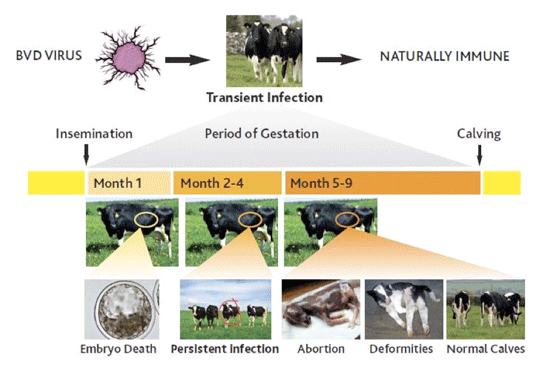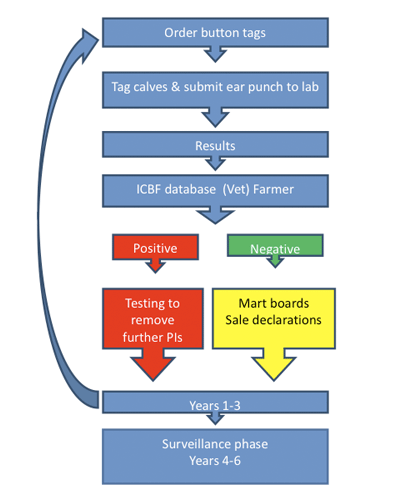



BVD - A National Eradication Programme 2012
David Graham, from Animal Health Ireland looks at a national eradication for bovine viral diarrhoea (BVD).What is BVD?
BVD is a viral infection of cattle. The single biggest impact of the disease is on fertility, where infection of susceptible cattle can produce a range of negative outcomes depending on the stage of breeding or pregnancy, as shown below:

From 30 days through to between 90 and 120 days of pregnancy is a critical time. If an unborn calf becomes infected during this period and is born alive rather than aborted, it will inevitably be persistently infected (PI). These PI cattle have high levels of virus in their blood throughout their lives. They are highly infectious, with nasal discharges, saliva, faeces, urine, milk and semen all containing virus. These PI cattle are the key animals responsible for introduction and spread of infection.
PI cattle tend to die at a much younger age than healthy cattle. However, a proportion of PI cattle will survive to breeding age, with females always producing a PI calf.
It is estimated that around 0.75 per cent of cattle in the national herd is PI, with these being present in around 25 per cent of herds. However surveys of bulk tank milk and blood samples have shown that almost all herds contain cattle that have been exposed to BVD virus, and that this has been the case for the last twenty years or more, suggesting that infection regularly cycles between herds.
How does infection get into a herd? The single biggest risk for introducing infection is through purchase of PI animals. For this reason either animals of unknown status should not be purchased or alternatively all purchased stock should be screened to ensure that they are not PI prior to release into the main herd. Note that pregnant stock can be carrying PI calves- even though the cows or heifers themselves test negative for virus. Therefore purchase of pregnant stock represents an even greater risk of introducing BVD. It is necessary not only to test the animals themselves, but to isolate and test their calves when they are born prior to releasing them into the main herd.
There are of course other avenues of introduction for BVD virus. These include contact with cattle from other herds e.g. at boundaries, when animals break in or out of herds, at shows and sales, through visitors and shared equipment. All of these risks also need to be adequately addressed to prevent infection re-entering herds but the single biggest risk remains the purchase of PI animals or non-PI animals carrying PI calves. It is essential to put in place adequate pre- or post-purchase testing to ensure this does not happen.
Experience elsewhere in Europe has shown that the knowledge and techniques to eliminate BVDV at a national level are available, with identification and removal of PI animals being the key. A consultation process earlier in 2011 indicated strong support for an industry-led national eradication programme, and Animal Health Ireland is participating in a BVD implementation group (BVDIG) to take forward the planning and delivery of this programme.
How will the programme work? The consultation process identified a preference for a testing programme based on ear punch samples as part of an intensive programme to identify and remove PI animals. The programme will begin with a voluntary period on 1st January 2012, and is intended to become compulsory in January 2013. An overview of the programme is given below.
Samples will be collected using a button tag labelled with the official identification number of the each animal. The first step to take to participate in the programme is to order the button tags for 2012. A set of button tags numbered to match your official tag order is available from Mullinahone Co-op and may be obtained by submitting an order form (available to download from www.Mullinahonecoop.ie or www.animalhealthireland.ie) or by telephone on 052 915 3102. A separate order form is also available to allow you to order button tags to match any official tags carried over from your previous order 2010.
Calves should be tagged as soon as possible after birth (certainly within five days) and the tissue punches sent to a laboratory for testing (the BVDIG has designated a number of laboratories for this purpose, and details, including costs, can be found on www.animalhealthireland.ie and will also be available in the farming press. These laboratories will report results directly to the ICBF database which will inform herd owners each time new results are received. Results on the database will only be accessible to the herd owner, unless he or she specifically enables a third party (such as their veterinary surgeon) to access the results also.
Herds with negative tests for all calves in the first year will simply continue the process of tag testing of calves in the following years. Since a negative calf result also indicates that the dam of that calf is not PI, several rounds of negative tag testing of calves will give very strong evidence that the herd is free of infection. It is vital that each calf is correctly matched to its mother and that this is accurately recorded.

Since a negative virus result means that the animal is not PI (and cannot become PI later in life), this result can be used to show that cattle presented for sale are non-PI. Systems are currently being put in place to allow display boards at marts to confirm that animals have had a negative virus test. Also herd owners who may be selling animals directly off-farm will be able to generate health declarations from the ICBF website showing negative results for their animals.
Where virus positive results do occur, the option to re-test these animals to confirm that they are PI will be available. Additional testing will be required in the herds to identify and remove any other PI cattle, with an initial focus on the dam. PI cattle should be culled from the herd as quickly as possible.
A surveillance phase, based on targeted blood sampling of young stock (plus bulk tank milk in dairy herds) will be used in the second part of the programme to confirm that herds are remaining free of infection.
AHI recently commissioned the Scottish Agricultural Colleges to undertake a modelling study of losses due to BVD. The study estimated annual losses in Ireland of at least €102 million, consisting of €55, €27 and €20 million in the dairy, suckler and finishing sectors respectively. At the animal level this is equivalent to an average of €48/year for every dairy cow and €30/year for every suckler cow.
The study also modelled the costs of the anticipated eradication programme to determine the economic viability of the proposed approach. Calculations show the estimated total cost for the six year eradication programme to be €49 million with €21 million and €28 million attributed to the dairy and suckler sectors respectively. Based on these figures, it is estimated that the annual losses due to BVD infection during the six year programme exceed the annual eradication costs by a factor of at least 10. When analysed in terms of pay-back period, the total costs of the programme in the suckler sector would be recouped by saving just over one year’s losses, while the costs in the dairy sector would be recouped in around six months.


